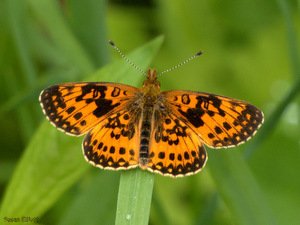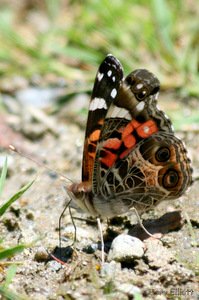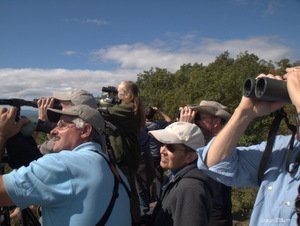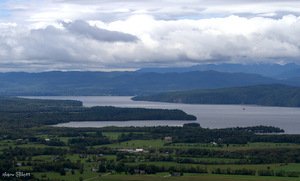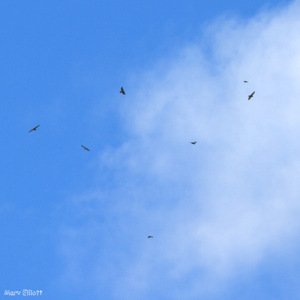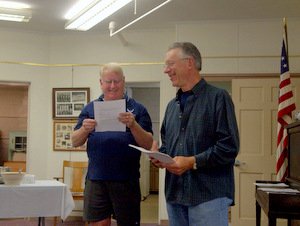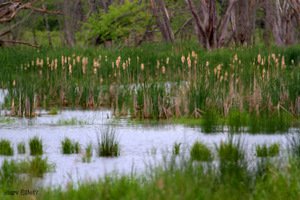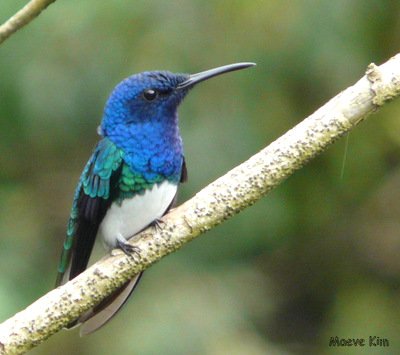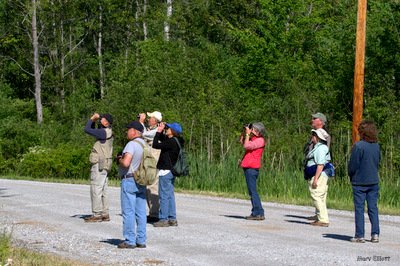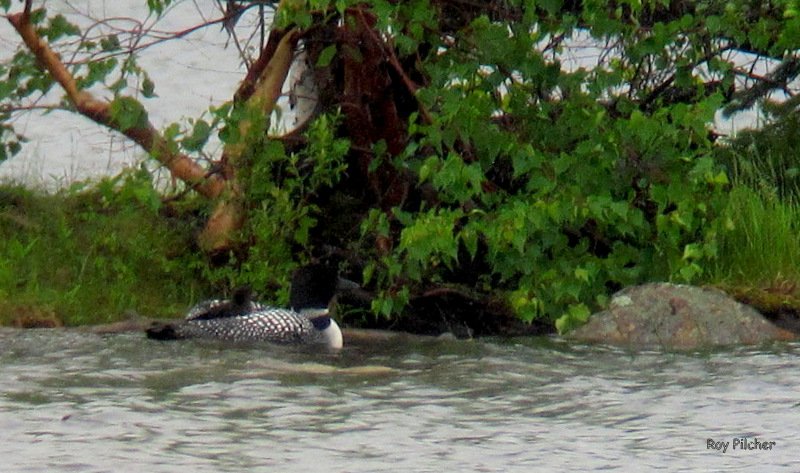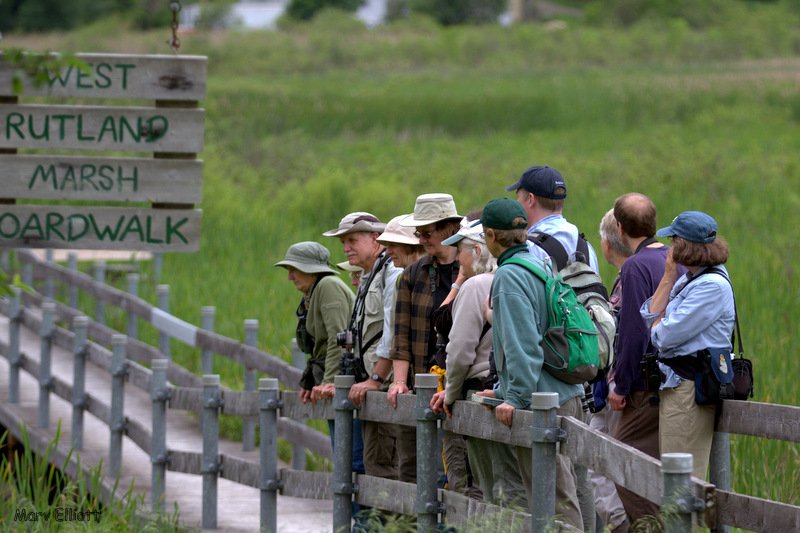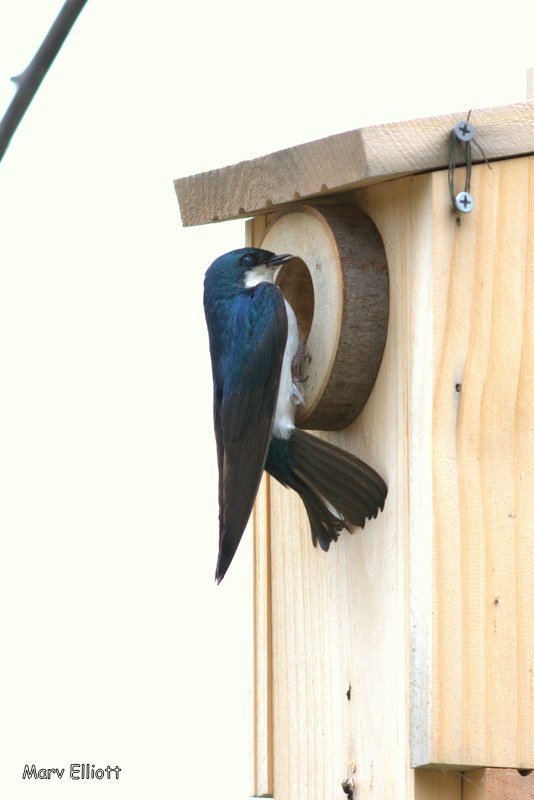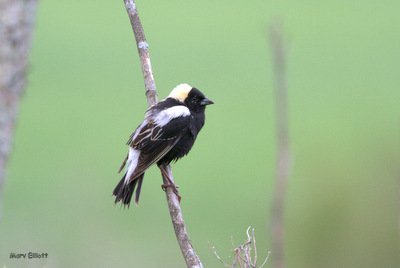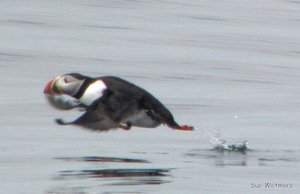 Atlantic PuffinMy husband Larry and I attended Audubon Camp on Hog Island, Maine, in June. The session we attended was called The Joy of Birding. Mid-afternoon on Sunday, June 9th, we boarded a boat along with some of the other campers. It took us the ¼ mile trip to Hog Island. After getting settled in our room, we went down to the main gathering spot, and what was the first thing that happened? A porcupine strolled leisurely around the dining building, oblivious to everyone, climbed an apple tree, ate some leaves, and promptly went to sleep. The next thing that happened was hearing and seeing a very cooperative Northern Parula, a warbler and a life bird for me, which turned out to be the first of many that live on the Island. This was a great beginning to the adventure of the next few days. We then all gathered in a circle in the Fish House and introduced ourselves. There were almost 60 campers from states all over the country (Texas, California, Virginia, New Mexico, Florida and Pennsylvania, to name a few) as well as Canada. We also were introduced to the camp leaders for that week: Chris Lewey, Rich Eakin, Wayne Petersen, John Pumilio, Sue Schubel, Pete Salmansohn, Clay and Pat Sutton, and Juanita Roushdy, who is also the president of Friends of Hog Island.
Atlantic PuffinMy husband Larry and I attended Audubon Camp on Hog Island, Maine, in June. The session we attended was called The Joy of Birding. Mid-afternoon on Sunday, June 9th, we boarded a boat along with some of the other campers. It took us the ¼ mile trip to Hog Island. After getting settled in our room, we went down to the main gathering spot, and what was the first thing that happened? A porcupine strolled leisurely around the dining building, oblivious to everyone, climbed an apple tree, ate some leaves, and promptly went to sleep. The next thing that happened was hearing and seeing a very cooperative Northern Parula, a warbler and a life bird for me, which turned out to be the first of many that live on the Island. This was a great beginning to the adventure of the next few days. We then all gathered in a circle in the Fish House and introduced ourselves. There were almost 60 campers from states all over the country (Texas, California, Virginia, New Mexico, Florida and Pennsylvania, to name a few) as well as Canada. We also were introduced to the camp leaders for that week: Chris Lewey, Rich Eakin, Wayne Petersen, John Pumilio, Sue Schubel, Pete Salmansohn, Clay and Pat Sutton, and Juanita Roushdy, who is also the president of Friends of Hog Island.
At dinner at 6:00 we learned all the procedures for the week. Everyone was responsible for making the dining area run smoothly. If you sat in a particular seat, you were the “hopper” that day and were the one who took all the dirty dishes to the dishwashing crew. Everyone had a cloth napkin that was hung with a personalized clothespin on a line after using and was your napkin for the week. There was no waste – all uneaten food left in serving dishes was returned and reappeared later in a different guise. There was a compost bin. Each leader sat at the head of a different table so campers were able to chat with them, ask questions, and just get to know them on a more personal basis. I was impressed.
Immediately after dinner, we reconvened in the Fish House. Pete Salmansohn, who is involved with Project Puffin, gave a presentation on the history of Hog Island, and Chris Lewey presented Maine Coastal Ecology. This turned out to be a nightly pattern: dinner at 6:00 followed by a presentation at 7:15 by one of the leaders or a guest. We were treated to Hawks by Clay Sutton, Island Birds by Rich Eakin, Migration by Scott Weidensaul, and Puffins by Steve Kress, who has directed the Puffin Project since 1973. After the presentations, the schedule for the following day was announced. Each morning there was an early bird walk at 5:45, breakfast at 7:00, and 8:15 the time to meet your group for the daily field trip. The campers had been divided into groups named after birds. On Monday, our first full day of camp, the Loons and the Parulas were going on the boat trip to Eastern Egg Rock to see Puffins. The other two groups (Gulls and Terns, I think) would be going on a mainland birding trip. Since Larry and I were Loons, our first day would be exciting.
We went back to our cozy, but small, room. Since our accommodations in the Queen Mary building held 18 campers, but only two bathrooms and two showers, getting ready for bed involved some waiting in line. This was something new for me. I had never gone to camp as a kid. But everyone was patient and nice, so it worked out.
Monday morning, I awoke at 3:30a.m. and couldn’t get back to sleep. I guess I was eager to get going. Every morning there, I woke up by 4:30. I think it was the sun shining in our east facing window. I literally woke up with the birds. So that first day, I went on the early morning bird walk – heard more Parulas, and Juncos were trilling. Right behind the dining building there was an Osprey sitting on a nest that had two chicks in it (we later got to see this on a birdcam in the dining room).
The weather was absolutely perfect for our boat ride. The sun was shining and the sea was calm. Along the way to Eastern Egg Island, which is about 8 miles from Hog Island, we saw Bald Eagles, Ospreys (sometimes in conflict with each other), Eiders, Black Guillemots, and many gulls. Sue Schubel, another veteran of Project Puffin, provided a running commentary of what we were seeing as well as the history of puffins on Eastern Egg Island. We stopped to look into the water to see how abundant the fish were and why that area in the Gulf of Maine draws so many birds to it. When we finally reached the island, we were not disappointed. There were many puffins, some as close as ten feet from the boat (no need for binoculars). There also were more guillemots, two Razorbills, cormorants, and Roseate, Common, and Arctic terns.
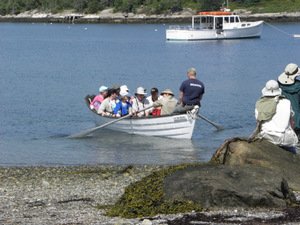 When we all had had our fill of puffins (if that’s possible!), we sailed to Harbor Island to have lunch and for some afternoon field trips. Since I had trouble getting on and off the boat and into a motorboat to get onto the island, I opted for the easy field trip, a walk in a typical low, shrubby habitat, where we encountered many Common Yellowthroats, Yellow Warblers, Song Sparrows, a few Gray Catbirds, and an Alder Flycatcher, among others. One of the two other groups had gone on a challenging geology walk, and the other walked a moderate trail, the highlight of which was a Great Horned Owl and her owlets nesting behind the property of the one family that had a home on the island.
When we all had had our fill of puffins (if that’s possible!), we sailed to Harbor Island to have lunch and for some afternoon field trips. Since I had trouble getting on and off the boat and into a motorboat to get onto the island, I opted for the easy field trip, a walk in a typical low, shrubby habitat, where we encountered many Common Yellowthroats, Yellow Warblers, Song Sparrows, a few Gray Catbirds, and an Alder Flycatcher, among others. One of the two other groups had gone on a challenging geology walk, and the other walked a moderate trail, the highlight of which was a Great Horned Owl and her owlets nesting behind the property of the one family that had a home on the island.
Back on Hog Island in late afternoon, we then had dinner and a presentation on hawks by Clay Sutton. The schedule for the next day involved a major change to Plan B since the weather report was forecasting a bad storm. The Gulls and Terns would not be able to do the trip to Eastern Egg Island as scheduled.
Plan B on Tuesday consisted first of a panel discussion with the leaders about how to become a better birder. The discussion was interesting. We spent a good deal of time discussing the use of audio playback when bird watching. After that campers could choose from presentations given by each of the leaders. These ran the gamut of topics from painting birds to the first year of life of a passerine, storytelling, how to spot owls, gardening for birds and birds asleep. One of the two I chose to attend was called Unfamiliar Facts, Familiar Faces given by Wayne Petersen. I learned that, while most birds learn their songs from their dads, tyrant flycatchers, like our Willow, Alder, Phoebe, Kingbird, etc., are genetically programmed and know their song inherently. I really wanted to see the Birds Asleep presentation, but decided that I needed some sleep myself by that time. Larry had been snoozing most of the day, which had turned out to be pretty stormy, with a lot of rain and a chilly wind. For most of the week it was cool with temperatures in the 60s. I was glad I had packed mostly warm clothing, and most days wore three layers.
Wednesday’s weather was considerably better, but still cloudy and drizzly. The Gulls and Terns groups got to go see puffins, while our group did the mainland birding trip. We stopped at several roadside places where we heard Brown Creeper, Canada Warbler, and Hermit Thrush singing, but they wouldn’t show their faces. At a wonderful place managed by the Damariscotta River Association, we heard a Sora and got good looks at it and a family of Pied-billed Grebes. There were also many swallows and Bobolinks in an adjacent field. Next we visited a blueberry barren, where I got to see another life bird, Vesper Sparrow. An American Kestrel was there also.
The leaders were excellent. They knew where the birds were, were very judicious in their use of playback, and they all knew so much about the plants, flowers, trees, and ferns that we were seeing. They answered our questions with knowledge and clarity.
That evening, we had a real treat. Scott Weidensaul was the guest speaker. He gave a passionate talk on bird migration, in which he described some of the amazing things that have been learned about bird migration in the past several years with the use of geolocators. Some birds are traveling much greater distances during migration than had been thought, and their bodies undergo incredible physiological changes that enable them to do this. He ended with a call for people who care about birds to drink shade-grown coffee, plant their gardens with flowers that attract birds, keep their cats indoors, and work toward educating people to do this, and support organizations that advocate for birds.
The following morning (Thursday, which was our last full day of camp) began bright and early. Several mist nets had been set up around the area, and we watched as Scott Weidensaul banded birds that had been caught including a Ruby-throated Hummingbird. It had an incredibly tiny band placed around its leg.
After breakfast, the groups split up, half doing a mainland Medomak bird walk, and the others taking a boat to Ross Island to see nesting gulls and chicks. Our group did the Medomak walk first, which was a loop trail around private land whose owners allow Audubon access to it. We heard more parulas, had good looks at a Black-billed Cuckoo, and explored a wetland area that was part of the property. Larry and I passed on the afternoon boat trip to Ross Island because it would involve walking on slippery rocks and I would have had to stay on the boat. But we heard from others that it was a great trip, and some even got to hold gull chicks in their hands.
The last evening at Hog Island was a treat. Those who chose were served freshly cooked lobster. Dessert was cream “puffins,” homemade cream puffs embellished to look like puffins! Steve Kress presented a talk on Project Puffin, which he has headed up for forty years. It was amazing to learn of the dedication and perseverance of the people who singlehandedly managed to bring puffins back to Eastern Egg Island. Afterward, awards were given out for best “hopper” in the dining room and winner of the Mystery Quiz, which involved answering a bird-related question from a different leader, posted each day in the lab. Needless to say, I didn’t win either prize, but I had fun researching the answers to the quiz in the small amount of spare time that we had. Finally, good-byes were said, and everyone scurried back to their rooms to pack for a very early Friday morning boat ride to the mainland and to catch flights or pick up cars to carry us home. All in all, Larry and I had a wonderful time. We were glad we had made the trip to Hog Island. We now have some very happy memories of our time there.
For more information about Audubon/Hog Island, click here.
 Red-breasted Nuthatch It’s that time again – to fill our feeders and watch the birds from the warm comfort of our own homes. Plan to stock up on Saturday, November 2 at the annual RCAS birdseed sale and membership drive at Garland’s Agway on Park Street in Rutland. Hours run from 8 AM to 1 PM.
Red-breasted Nuthatch It’s that time again – to fill our feeders and watch the birds from the warm comfort of our own homes. Plan to stock up on Saturday, November 2 at the annual RCAS birdseed sale and membership drive at Garland’s Agway on Park Street in Rutland. Hours run from 8 AM to 1 PM.

